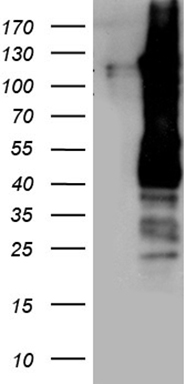SAPS2 (PPP6R2) Rabbit Polyclonal Antibody
USD 159.00
USD 396.00
Specifications
| Product Data | |
| Applications | WB |
| Recommended Dilution | WB: 1:500~2000 |
| Reactivities | Human, Mouse |
| Host | Rabbit |
| Isotype | IgG |
| Clonality | Polyclonal |
| Immunogen | Recombinant protein of human PPP6R2 |
| Formulation | PBS with 0.02% sodium azide, 50% glycerol, pH7.3 |
| Concentration | 2.5 mg/ml |
| Purification | Purified from the immunized serum by affinity chromatography (Protein A/G) |
| Conjugation | Unconjugated |
| Storage | Store at -20°C as received. |
| Stability | Stable for 12 months from date of receipt. |
| Predicted Protein Size | 101.1 kDa |
| Gene Name | protein phosphatase 6 regulatory subunit 2 |
| Database Link | |
| Background | Protein phosphatase regulatory subunits, such as SAPS2, modulate the activity of protein phosphatase catalytic subunits by restricting substrate specificity, recruiting substrates, and determining the intracellular localization of the holoenzyme. SAPS2 is a regulatory subunit for the protein phosphatase-6 catalytic subunit (PPP6C; MIM 612725) (Stefansson and Brautigan, 2006 [PubMed 16769727]). [supplied by OMIM, Nov 2010] |
| Synonyms | KIAA0685; PP6R2; SAP190; SAPS2 |
| Reference Data | |
Documents
| Product Manuals |
| FAQs |
Resources
| Antibody Resources |
Other Versions
| SKU | Description | Size | Price |
|---|---|---|---|
| TA890148 | Rabbit Polyclonal anti-PPP6R2 Antibody |
USD 345.00 |
{0} Product Review(s)
Be the first one to submit a review






























































































































































































































































 Germany
Germany
 Japan
Japan
 United Kingdom
United Kingdom
 China
China




